Acknowledgments We thank Tuttle Publishing for the opportunity to revisit our origami butterfly designs with both diagrams and video instructions to make these projects more accessible and enjoyable. We are grateful to our editor, Jon Steever, for his expert guidance and careful editing, and to the rest of the talented Tuttle team. We gratefully acknowledge the graphics design work of Greg Mudarri, who helped us with our first book of origami butterfly designs at Origamido Studio, and we thank him for his past contributions and continued friendship. Finally, these designs could not have been developed without the inspirational works of Akira Yoshizawa, who also influenced Russell Cashdollar. Their prior origami butterfly designs provided both seed and fertilizer for this Field of Discovery! 
 The tessellated fabric background is Dodecagon Whirl Spools, folded silk , from Shadowfolds by Chris K.
The tessellated fabric background is Dodecagon Whirl Spools, folded silk , from Shadowfolds by Chris K. 
The Metamorphosis of an Origami Artist by Richard Alexander, Origamido Studio Cofounder Decorative paper folding has been around for at least a few hundred years in Japan, but this early repertoire seems to include only a few dozen models.

The Metamorphosis of an Origami Artist by Richard Alexander, Origamido Studio Cofounder Decorative paper folding has been around for at least a few hundred years in Japan, but this early repertoire seems to include only a few dozen models.
In 1937, Akira Yoshizawa embraced origami as his occupation. By 1952, a commission by Asahi Graf for a new set of zodiac origami brought him fame. The response encouraged him to continue to design new origami in his own style of expressive paper folding. Yoshizawa is now considered by many to be the father of expressive art origami. Michael G. LaFosse grew up in Fitchburg, Massachusetts.
Even as a young child he was particularly good at making things of paper, and he worked his way through the craft and origami books at the local library. He was a teenager when he saw color photos of works by origami master Akira Yoshizawa in a 1970 article in Readers Digest . This was the first time he realized it was possible to design your own origami. It was also the first origami he considered as expressive art, and he read that article over and over again. The powerful photos alone gave him the aspiration to become an origami artist! He realized that Yoshizawas paper was much different than any he had seenmuch heavier than any he had folded. Yoshizawas paper allowed softer folds and expressive, curved lines.
Fortunately for him, Fitchburg was a paper-making town, so Michael was able to learn about paper-making processes and materials from his friends parents who worked in the mills. Eventually he found a way to make whatever type of paper he needed for his folded art, and he soon learned to locate quality materials in the Boston area. The origami books Michael had borrowed had mentioned Lillian Oppenheimer and her Origami Center of America in New York City. In 1977, Michael found himself in New York, and he paid an initial visit to Lillian. A short time later, he returned with his origami creations, and showed her his realistic bat, cattleya orchid, horseshoe crab, and several lifelike birds. Lillian invited several friends to see his works and to fold with Michael.
He spent a week there, sleeping on Lillians couch, and met Michael Shall, who taught him how to fold Akira Yoshizawas butterfly (from a waterbomb base). During this visit he also met Alice Gray, who worked in the entomology section at the American Museum of Natural History. She admired his complex praying mantis, and she invited him to see the insects at the museum. As they rode the subway uptown to the museum, Michael folded his first origami butterfly from a pink, 8 x 11 piece of scrap paper. Alice admired it, but lamented it was not from a square. The bus trip back home to Fitchburg gave him hours for exploration, and he settled on three variations of the Butterfly for Alice Gray, each folded from a square.
At the time, Michaels complex models were dismissed by some in New York as paper sculpture, and not really origami the way they saw it, so he did not return to New York for many years. Even so, he was still actively creating and folding origami art during that period. Most of his signature works were developed in that time. He even published and sold drawings for his origami F-14 Tomcat Fighter Jet (one of 28 original paper airplane designs that now appear in the hardcover book and DVD set, Planes for Brains , (Tuttle Publishing). We met in 1988, when Michael was working as a chef, and folding in the wee hours of the morning after the restaurant had closed. His apartment had piles of crumpled paper, and I was overwhelmed by the beauty and complexity of his origami masterworks the first time I saw them.
I found his work so spectacular, I offered to help him exhibit it, and soon we were mounting and framing it, videotaping his folding sequences, and making special papers in the garage. We set up exhibits at craft fairs and museums. Buoyed by the publics response, Michael called Lillian in 1991, and the timing could not have been more perfect. She invited him to a master class by Akira Yoshizawa in Ossining, New York, which is where he finally met Yoshizawa (as well as Emiko Kruckner, Jonathan Baxter, and other advanced folders from all over the country).  A Butterfly for Emiko Kruckner visits Michaels origami Munich Orchids.
A Butterfly for Emiko Kruckner visits Michaels origami Munich Orchids.  Russell Cashdollar designed and folded this display of colorful origami butterflies, which inspired LaFosse to revisit and expand his own folded butterfly repertoire.
Russell Cashdollar designed and folded this display of colorful origami butterflies, which inspired LaFosse to revisit and expand his own folded butterfly repertoire.
We met more serious origami artists at our first origami convention of the Friends of the Origami Center, held in 1992 at a public school in New York City. One of the more memorable and colorful displays was a collection of brightly patterned origami butterflies, designed and beautifully folded by Russell Cashdollar, a folder from the Washington, D.C. area. Inspired by Russells work, Michael recalled his Butterfly for Alice Gray that hed designed and folded in 1978, and he began to revisit the potential for his butterfly base. We recently called Russell to ask if he had a photo of those original butterflies from 1992 that we might add to this book. We began to reminisce with him about how his display had inspired Michael to revisit earlier works.
Russell recalled that his butterflies had also prompted the noted origami creator and author, John Montroll, to explore a variety of models that displayed both sides of the paper. John published a remarkable collection of such designs in his book, Origami Inside-Out (Antroll, 1993). After some extensive searching, Russell not only found his original models, he took a look at Michaels butterfly designs and went back to explore more variations of his own! He had originally started with a Yoshizawa butterfly design, and more recently has developed several new designs from frog and lily bases. Lasell College invited Michael to set up a two-floor show of original origami art at their Yamawaki Art & Cultural Center in Newton, Massachusetts in 1994. The show included several butterflies folded from his handmade papers. We also released a self-published video folding tutorial, Origami Butterflies & Moths that provided close-up shots of Michael masterfully working the detailsshaping, curling, and tweaking the models.
Next page
![Alexander Richard L. Michael LaFosses Origami Butterflies: Elegant Designs from a Master Folder [Full-Color Book & Downloadable Instructional Media]](/uploads/posts/book/171883/thumbs/alexander-richard-l-michael-lafosse-s-origami.jpg)

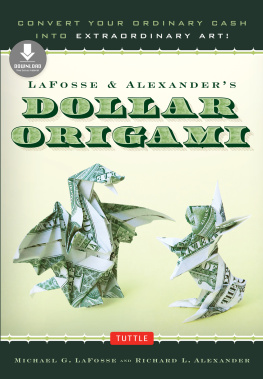
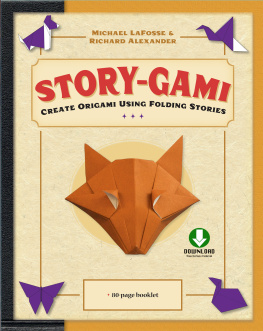

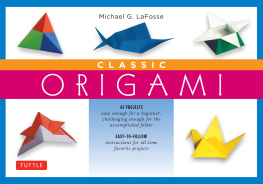
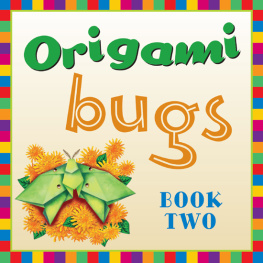
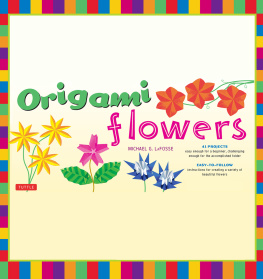
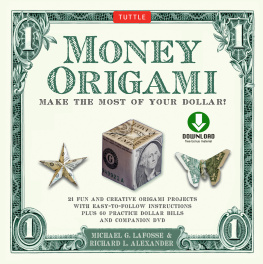
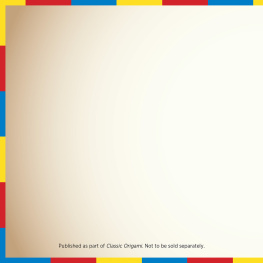


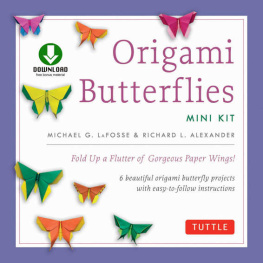

 The tessellated fabric background is Dodecagon Whirl Spools, folded silk , from Shadowfolds by Chris K.
The tessellated fabric background is Dodecagon Whirl Spools, folded silk , from Shadowfolds by Chris K. 
 A Butterfly for Emiko Kruckner visits Michaels origami Munich Orchids.
A Butterfly for Emiko Kruckner visits Michaels origami Munich Orchids.  Russell Cashdollar designed and folded this display of colorful origami butterflies, which inspired LaFosse to revisit and expand his own folded butterfly repertoire.
Russell Cashdollar designed and folded this display of colorful origami butterflies, which inspired LaFosse to revisit and expand his own folded butterfly repertoire.